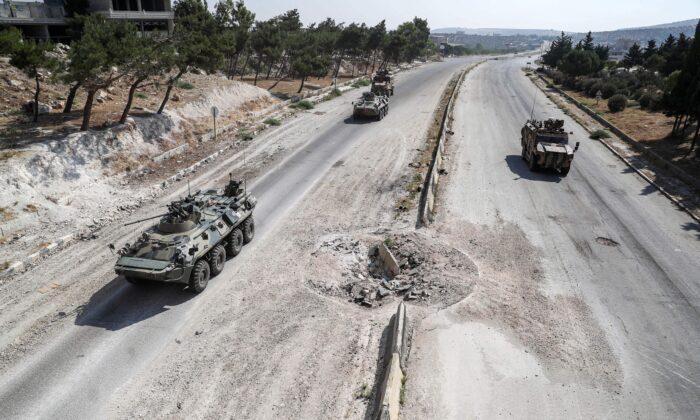Since Russia’s invasion of Ukraine early last year, countless videos have emerged from the frontlines. Often recorded by combatants themselves, they portray scenes of trench warfare, fiery drone strikes, and gruesome atrocities allegedly committed by both sides.
Posted on social media sites and often published, in turn, by media outlets, sensational footage has become a regular staple of the ongoing conflict.
One recent example shows two Ukrainian soldiers frantically defending a bombed-out trench from a determined assault by Russian infantry. Originally posted on TikTok, the action-packed video was widely shared on social media, racking up millions of views.

Videos are typically filmed using GoPro cameras—or “action cams”—mounted on soldiers’ helmets or gun barrels.
The technique lets viewers see the action from the combatant’s perspective, often making for a gut-wrenching viewing experience.
Lust for Revenge
Footage captured by frontline soldiers is hardly a new phenomenon. In recent years, countless “point-of-view” videos depicting harrowing scenes of combat have appeared on popular video-sharing sites.Many of them feature U.S. military personnel in various hotspots, including Iraq and Afghanistan.
One YouTube channel, FUNKER530, has been posting such footage for more than a decade. Its most popular video, in which a U.S. soldier equipped with a helmet cam sustains multiple hits from Taliban fighters, boasts 46 million views.
But as action cams and aerial drones become cheaper and more widely available, the trend has become more widespread—and more gruesome. This is especially the case in the Russia–Ukraine theater, where frontline footage has proliferated in recent months and new videos appear on an almost daily basis.
Numerous Telegram channels, both Russian and Ukrainian, are devoted exclusively to showcasing—and celebrating—drone strikes, along with other scenes of death and destruction.

In some cases, the footage is set to rock music or interspersed with Hollywood memes. In others, successful drone strikes are accompanied by the laughter and cheers of off-screen narrators.
While casual viewers might find this repugnant, military experts say the practice is an inevitable feature of war.
“War produces traumatic, high-stress environments that are typically characterized by anger and vengeance,” Abdullah Agar, a prominent Turkish military commentator and former Special Forces officer in the Turkish armed forces, told The Epoch Times.
“When soldiers see their comrades killed—literally blown to bits—in front of their eyes, they become driven by a desire to exact revenge.
‘Realities of War’
In several cases throughout the conflict, footage has emerged online that appears to show the perpetration of war crimes by one side or the other.In November 2022, a series of videos emerged that appeared to show captive Russian soldiers being executed by Ukrainian troops. Believed to have been taken in the town of Makiivka, Ukraine, the incident was widely covered by the Western media.
Even The New York Times ran a story on the disturbing footage, the authenticity of which it claimed to have verified.
According to Russian officials, the videos clearly show Ukrainian soldiers killing unarmed Russian troops who had already surrendered. Officials in Kyiv, for their part, said its soldiers were acting in self-defense after having been fired upon.
“Regardless of the reality of the situation, the violent acts depicted in such videos are to be expected in wartime,” Agar said. “Civilians who witness such scenes may find them appalling, but they are—and always will be—the realities of war.”

Since it began, allegations of war crimes have been a central feature of the conflict in Ukraine.
In March 2022, peace talks in Istanbul were reportedly making headway, with both sides willing to make concessions. However, talks were abruptly halted amid claims that Russian forces had murdered civilians in the town of Bucha, Ukraine.
The United States and its allies, along with the Western mainstream media, unanimously backed Kyiv’s assertions. Moscow, however, still insists that the atrocity claims were fabricated.
New claims were leveled last month after a video emerged on social media that appears to show Russian soldiers beheading a Ukrainian captive. Purportedly filmed by a Russian soldier, the incident is said to have occurred near the flashpoint town of Bakhmut, Ukraine.
“There is something no one in the world can ignore: how easily these beasts kill,” Ukrainian President Volodymyr Zelenskyy said following the video’s appearance.
Ukrainian Foreign Minister Dmytro Kuleba compared Russian soldiers to the ISIS terrorist group, which earned notoriety in Syria and Iraq for purportedly cutting off the heads of its adversaries.
“Russian terrorists must be kicked out of Ukraine—and the U.N.—and be held accountable for their crimes,” Kuleba said.

Kremlin spokesman Dmitry Peskov described the scene portrayed in the video as “horrible.” But he also warned against drawing hasty conclusions.
“In the world of fakes that we live in, we need to check the veracity of this footage,” he told reporters.
Peskov also called for investigations to determine “whether this happened—and if it did, where and by whom.”
Russian officials have previously accused Ukraine of cutting off the heads and hands of slain foreign mercenaries so they can’t be identified—an allegation denied by Kyiv.
Agar, for his part, shared Peskov’s skepticism, saying that gruesome “atrocity” footage is often a feature of so-called “false-flag” operations.
“Such operations aim to discredit the enemy by making them appear as ruthless war criminals,” he said. “They can also be used to drum up support among one’s own population.”
According to Agar, “deception, propaganda, and psychological operations” have always been central features of war.
He noted that grizzly images can be effectively used “to manipulate public opinion, create false perceptions, and legitimize conflicts that wouldn’t otherwise be condoned by the international community.”





